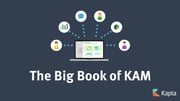4 Customer Success Tools to Achieve Value-Based Outcomes
in Customer Success /Customer success doesn’t come without a fair amount of trepidation all the way around. For the customer, adopting a product or service requires change — sometimes massive change across their entire organization. For customer success teams, it requires constant vigilance, agility, and alignment with others to help customers achieve optimal results over time.
What it really means is that everyone has to be on the same page and moving in the same direction, but how to put that theory into practice is the question.
At KAMCon 2018, Tom Murray, senior engagement director at Pivotal Software, outlined several tools customer success teams can implement to help them continually share, learn, adapt, and measure, on pace and at scale, while pursuing the ultimate reward: value-based customer outcomes.
Three principles in practical terms
Customer success is predicated on three principles: your team has to 1) share the same intent with your customer and account teams, 2) put the customer at the center of all strategy and focus, and 3) consistently orient and drive toward their desired outcomes.
By bearing these principles in mind and utilizing tools that realize them on a practical level, everyone can move faster, collaborate more effectively, and measure success with more confidence. Here’s how:
1) Intent-led
Understanding the intention — why are we all here and what are we really trying to achieve — is the first step to reaching a common goal. Staying intent-led can be done through:
Tool #1: Voice of Customer:
Look through the lens of your customer and speak with their voice by answering these questions: What are the outcomes the customer wants to achieve and by when? Who cares about achieving these outcomes? And how does our proposed solution deliver these outcomes?
Tool #2: Customer journey:
A customer’s journey doesn’t stop with a product launch. Extending and scaling are often next phases of the journey that require their own mapping. For each of your customers, map out their journey from launch through engrainment or regular usage to scalability, and any other phases that may exist for them.
2) Customer-centered
If you’ve heard of the 5 Whys, then you’ll know where this is headed. To develop a truly deep connection to your customer and a shared understanding of their goals, you need to get to the root of what they’re trying to do or solve and why. Only then can you build trust with the customer and become a go-to source of knowledge and support throughout their journey. Staying customer-centered can be done through:
Tool #3: Engagement plan:
To understand your customer’s strategic objective, you need a framework that defines and helps you deliver against it. Start high with the overarching objective, then break it down into smaller goals, milestones, and individual efforts that are each achievable and measurable over time. This can be done with PowerPoint presentations; spreadsheets; graphs, charts, and other visuals; and even customer dashboards — anything that can be shared with the customer to help them see where they’re at during any given point in the engagement.
Tip: Because there are often versioning and history issues with shared documents, a solution like Kapta is one of the best ways to create, update, and share your engagement plan.
3) Outcomes-oriented
In this day and age, outcomes have to be measurable. How is success quantified and how do you know what’s working or what needs to be improved? Staying outcomes-oriented can be done through:
Tool #4: Outcomes framework:
Customer outcomes are directly tied to the ecosystem in which they operate: their organizational structure, industry, competitors, and other factors. Create a framework to understand the external (and internal) forces applying pressure on their organization; the business outcomes that are most important to them; how your product or service impacts the realization of those outcomes; and which aspects of their operations today will require a different approach down the road.
Remember: Anything that shows metrics — health markers, account reviews, value-stream mapping, scorecards — keeps the customer informed of their own forward progress and the value they’re receiving.
When “speed” is the goal
Nearly every customer wants to move faster. But speed can often feel like running around in circles without having achieved much. What customers really mean by speed is velocity, which is comprised of direction and magnitude: moving steadily in a positive direction with a growing body of successes behind them, propelling them forward.
Where customer success teams can excel is in recognizing the difference between speed and velocity, and that alignment with the customer and with other teams and stakeholders is what enables it.
In a world that isn’t going to slow down any time soon, staying intent-led, customer-centered, and outcomes-oriented will help you meet the needs and goals of customers while maximizing your own focus and effectiveness.







